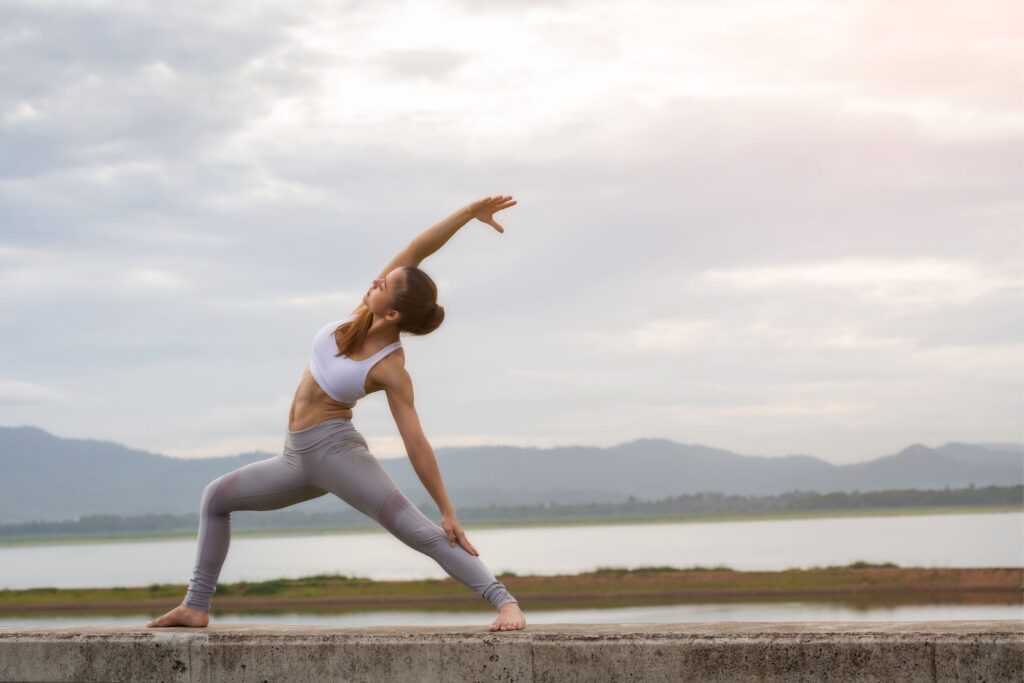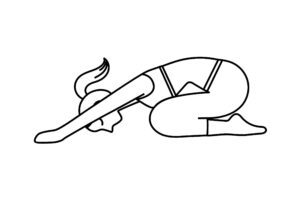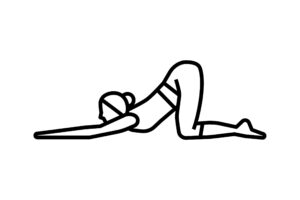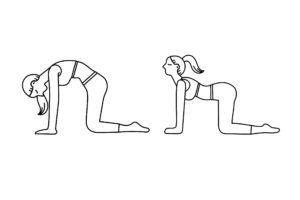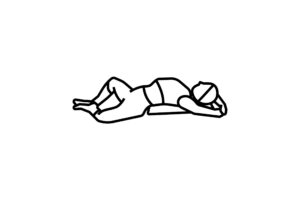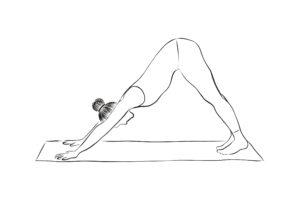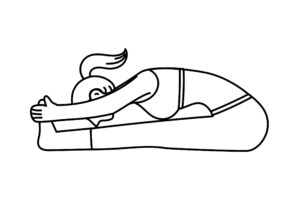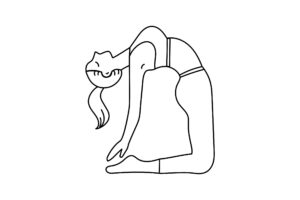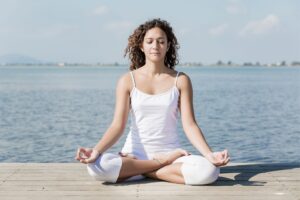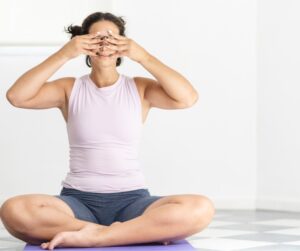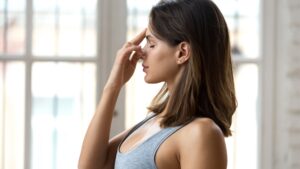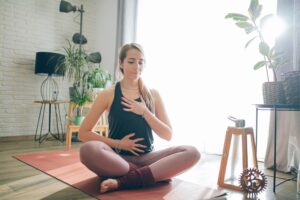Being too afraid or living in a constant state of worry are frequent mental health issues known as anxiety. Although everyone worries occasionally, anxiety is the result of worrying so much that it interferes with day-to-day functioning. Yoga for anxiety enhances self-observation which makes one aware of their thoughts and feelings.
Table of Contents
ToggleYoga Poses For Anxiety
Symptoms of anxiety mainly include elevated heart rate, nausea, stomach aches, gastrointestinal disorders, weakened immune system, sleep problems, body pains, low mood, feeling restless, and constant worrying. Yoga for anxiety releases tension, joint pain, digestive problems, and physical sensations of exhaustion.
Child Pose

- Place your knees slightly apart on the ground.
- Exhale and bend forward. Slightly tuck your chin.
- Extend the arms on the ground in front or extend them back toward the feet, palms up.
- Let the weight of the shoulders stretch the shoulder blades widely across the back.
- Breathe gently and deeply for 30 seconds.
Extended Puppy Pose

- Come to your fours in the tabletop position.
- Extend your hands forward and lower the body until you can release your head onto the floor while maintaining the hip position.
- Separate the shoulder blades and widen the shoulders.
Cat and Cow Stretch

- Starting on all fours, place your hands under your shoulders and your knees under your hips to perform the cat-cow stretch.
- Breathe in as you drop your belly, arch your back, and raise your head (Cow Pose).
- Breathe while bending your back and bringing your chin to your chest (Cat Pose).
Reclining Angle Bound Pose

- Lie down on your back.
- Bent your knees sideways so that the soles of the feet touch each other. Try to bring the feet closer to your buttocks.
- Feel the muscles in the groin stretching as you lower your knees toward the floor.
- Take a deep breath and stay in this posture for 30 seconds.
Downward Dog

- Come on all fours, place your hands under your shoulders and your knees under your hips.
- Raise the hips and straighten the legs. Tuck the toes beneath and push back through the hands.
- Spread the fingers on the mat for support.
- Move your shoulder blades from the ears toward your hips.
- Sink the heels toward the floor, rotate the thighs inward, and maintain a high tail.
- Ensure the space between the hands and feet is the same.
Forward Fold

- Sit with the legs extended in front.
- Contract the belly inward and gently press your sitting bones into the floor.
- Inhale and extend your back.
- Exhale and bend forward from the hips.
- Maintain a straight back and avoid overstretching.
- Hold your big toes if your hands reach your feet as you glide across.
- Keep your elbows bent, extending them outward, and keep your shoulders away from your ears.
- To extend the position further, raise your head slightly and lengthen across the front of your chest with each inhale.
- Try to fold farther into the posture with each exhale.
- Release the feet gradually, and take a breath to exit the pose.
- As you release, slowly take a seat upright.
Camel Pose

- Kneel and keep the upper body erect
- Place your feet flat on the floor with the soles facing the sky.
- Place the hand on the hips.
- Breathe in, pull the tailbone to the front, and gently arch the back.
- Breathe out and bring the right hand back to grasp the heels
- Bring the left hand in the same manner
- Stretch them as far as comfortable.
- Hold the posture for 5-10 breaths.
- To release, withdraw the hands, return them to your hips, and straighten up.
Breathing Exercises for Anxiety
One of the best strategies for calming down an anxiety attack is to slow down and pay attention to breathing. Pranayama, or breath control, is an effective way to relax the sympathetic nervous system.
Yoga for anxiety promotes deeper, steadier breathing patterns that stimulate the vagus nerve, and help the body and the mind respond better during stressful times.
Ujjayi Breath

- Sit comfortably and close your eyes
- Breathe gently through both nostrils.
- Now, bring the awareness to the throat.
- Slightly tighten the back of the neck for the practice.
- As you inhale, try to constrict the throat.
- The air making contact with the throat produces a hissing sound.
- Now, release the breath through the nostrils, producing the same hissing sound.
- Perform form 8-10 rounds.
Bhramari Pranayama

- Select a pleasant, quiet area and sit comfortably.
- Close your eyes, lengthen the spine, and relax your shoulders.
- Press the index fingers on the ear cartilage slightly above the earlobes.
- Inhale deeply through the nose.
- Exhale and make a soft humming sound in your throat.
- Pay attention to the sound and the sensations it elicits.
Read more about Bhramari Pranayama
Alternate Nostril Breathing

- Establish a connection with your breath.
- Make the Vishnu mudra. Fold the index and middle fingers inward until they make contact with the palm. You will seal the right nostril with your right thumb and the left nostril with your right ring finger.
- Inhale from the left nostril. To shut the right nostril, use your thumb.
- Take a moment to pause at the top of your head.
- Exhale from the right nostril. At the bottom of the exhale, pause slightly.
- Inhale through the right nostril.
- Exhale from the left nostril.
- This is one round. Continue for 10-15 minutes.
Diaphragmatic Breathing

- Sit comfortably on the mat.
- Put one hand on the chest and one hand on the abdomen.
- Breathe in softly through the nose. Ensure the chest is still.
- Exhale with the mouth as you lightly press both lips.
- Feel the abdominal muscles contract as you exhale.
- This completes one round.
Meditation for Anxiety
Persistent worrying may to negative thinking and depression. Practicing mindfulness enhances attention and concentration, which helps to reduce anxiety and helps one to take accountability for your physical and mental state.
There are many ways to practice mindfulness yoga for anxiety and yoga for depression. The effectiveness of any one exercise will vary based on the circumstances and mental state at the time. Try and experiment with a couple of them until you find the one that works best for your situation.
Connect With Nature
Taking a walk in nature may be a powerful tool to bring oneself back into the present moment. Observe the speed at which you start walking and let your breath follow the rhythmic changes with every step.
Notice the surroundings as you gently move the neck in all directions. The movement in the neck can relieve tension in addition to providing the mind with something to concentrate on.
Five Senses Meditation
Using the practice 5-4-3-2-1, bring all five senses back to the present moment. It helps to calm nervous feelings.
- Five objects that are visible to you
- Four objects that you can feel or touch
- Three things you can hear
- Two objects you can smell
- One thing you can taste
Body Scan
Body Scan one of the best yoga practices for stress and anxiety is a type of guided relaxation that reduces the physiological impacts of anxiety. It is also known as Yoga Nidra.
Spending a few minutes examining the body parts from head to toe may help to identify stiffness and let go of these sensations to become more adept at managing anxiety. You may also choose to perform some light stretches with respect to the body parts where you feel the tension.
Yoga for anxiety is a practice that enhances the connection between the mind and body, which includes breathing exercises, meditation, and stretching. Gentle stretching and movement promote the production of endorphins, which are natural mood boosters.
It also relaxes the nervous system and helps control the body’s stress reaction. However, it is critical to remember that help and support are always available whenever you require it. Consulting a medical professional or getting therapy in case of severity is essential.

